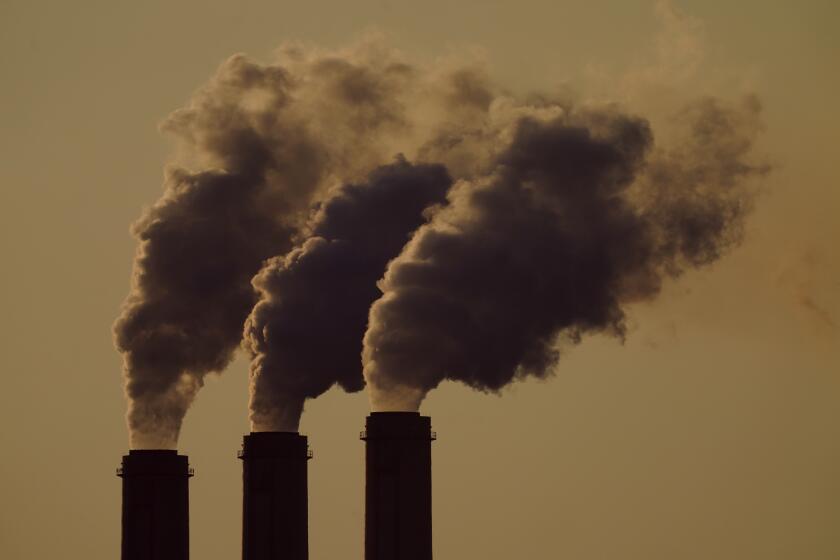President Trump has been trying to eliminate climate regulations since his first day back in office when he signed an executive order declaring the primacy of fossil fuels.
But his administration’s most radical step came last week, when the Environmental Protection Agency unveiled a proposal that would rescind its 2009 “endangerment finding” — the scientific conclusion that greenhouse gases contribute to global warming and harm human health and well-being.
This isn’t just another regulatory rollback. It’s an assault on the foundation of all federal climate policy.
Read more: As Trump’s EPA reverses landmark climate policy, California could lead a resistance
The endangerment finding originally applied to vehicle emissions, but it also underpins every major federal climate rule in America: car and truck emissions standards, power plant regulations and limits on oil and gas facilities. By removing this cornerstone, Trump’s EPA is repudiating federal authority to limit greenhouse gases, our most powerful tool for fighting climate change.
The irony is that no industry asked for this extreme step. Car makers need stable federal rules to compete globally. Power companies have invested billions in renewable energy, which regulatory uncertainty puts at risk. Even most oil and gas companies support a national approach to limiting methane.
Companies may stay quiet to avoid crossing a vengeful administration, but they know climate change is real and that some federal regulation makes business sense.
Read more: Trump’s EPA puts California in its crosshairs with its proposed car rules
As the federal government retreats, states such as California will try to fill the void. But Trump is trying to block them too, directing the Justice Department to challenge state climate policies. With its cap-and-trade program, renewable energy standards and clean transportation incentives, California is helping to cut harmful emissions, and it could do more. Yet even the most ambitious state measures can’t substitute for the national standards needed to tackle a problem the size of climate change.
The legal foundation the administration is attacking seemed unshakeable. The Clean Air Act requires the EPA to regulate air pollutants that endanger human health and welfare. In 2007, in Massachusetts vs. EPA, the Supreme Court ruled 5-4 that greenhouse gases are air pollutants, and that the endangerment decision must be based on science.
Two years later, after the EPA reviewed studies by the National Climate Assessment, the National Research Council and the U.N. Intergovernmental Panel on Climate Change, it found that greenhouse gases accumulating in the atmosphere are a danger, pointing to higher temperatures, worse air quality, extreme weather events, spreading drought and more food- and water-borne pathogens. Following the process set out in the Clean Air Act, the agency then established national emission standards for the sources in each sector of the U.S. economy that contribute to this problem.
Read more: How the EPA’s environmental about-face could upend California’s climate efforts
To unravel all of this, the Trump administration proposal offers a medley of strained legal and scientific arguments.
First, it claims that greenhouse gases are not pollutants because they have global, not local, effects. This argument is hard to square with the Supreme Court’s ruling to the contrary, but they are trying it anyway.
The proposal also asserts that U.S. emissions don’t contribute to harms from climate change because climate impacts are too remote and American emissions are too small a share of the global total to matter.
The first point demands a direct link between U.S. emissions and specific climate impacts, which is impossible to prove given that the effects of climate change are the result of global pollution from numerous sources. The second point rests on a contrived method for calculating emissions piecemeal, which makes them appear vanishingly small. No category of sources, whether cars or power plants, would produce a large enough share of greenhouse gases to justify regulation under this approach. It’s a test designed to be impossible to pass.
Read more: Rising heat is causing students to underperform across the globe
(Studies show, to the contrary, that every ton of emissions avoided counts when it comes to reducing climate risks, and that even incremental reductions bring significant public health and economic gains.)
The proposal goes on to attack the scientific basis for the endangerment finding, calling it unreliable based largely on a report from the Department of Energy written by five handpicked scientists known for their outlier views. The report asserts, among other things, that global warming is on balance more beneficial than harmful, that cold temperatures are the greater threat and that extreme weather events are not worse than they have been historically.
To say that such claims defy the consensus is an understatement. Relying on a commissioned report by a closed group looks especially suspect given that Trump disbanded the National Climate Assessment, a congressionally mandated periodic review conducted by hundreds of climate scientists and involving more than a dozen government agencies, which has warned of climate dangers in five reports since 2000.
Read more: Contributor: How California can cash in on federal incentives for green power before they disappear
The proposal also folds policy objections into the scientific assessment, asserting that regulating greenhouse gases simply costs too much and accomplishes too little. But this muddles the issues. Whether climate change is harmful is a purely scientific assessment. How stringently to regulate is a separate question that must weigh both costs and benefits. On that score, the proposal’s cost analysis is highly skewed, citing the burdens of regulation while ignoring the substantial public health and economic benefits of limiting warming.
In all, the proposal’s scattershot justifications seem designed to offer the conservative supermajority on the Supreme Court — where the issue will likely land — a variety of ways to agree.
After all, the five members of the Massachusetts vs. EPA majority have retired or died, while three of the four dissenters remain. The current court has steadily limited that decision’s reach by narrowing the EPA’s authority. Given their recent rulings, the justices could well reject the proposal’s most far-fetched arguments while concluding that the EPA simply has broad discretion not to regulate greenhouse gases. Even if the administration ultimately loses in court, it wins by paralyzing climate action for years.
Read more: Contributor: We still rely on gasoline. Why is California adding to the cost and the pollution?
As EPA Administrator Lee Zeldin put it in announcing the proposal, the administration is “driving a dagger through the heart of climate change religion.”
But climate change isn’t a religion — it’s physics and chemistry. And science doesn’t care about politics. We can’t solve climate change with regulation alone. But we certainly can’t solve it by pretending the problem doesn’t exist.
The administration’s assault on climate action won’t change the evidence or reality of climate change. As scientists have predicted, storms are growing more intense, heat waves more deadly, wildfires more destructive. We spend billions annually on disaster response while other countries surge ahead in clean energy innovation and manufacturing. China now dominates solar panel and electric vehicle production; Europe leads in offshore wind.
The question isn’t whether we’ll eventually return to responsible climate policy — we will because we must. The question is how much time we’ll lose, and how much damage we’ll suffer, while politics masquerades as good policy.
Jody Freeman is a professor and director of the Environmental and Energy Law Program at Harvard University. She was counselor for energy and climate change during the Obama administration.
This story originally appeared in Los Angeles Times.

